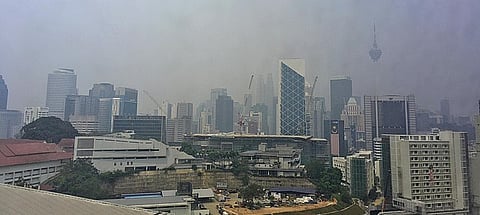
- Home
- न्यूजग्राम
- India
- World
- Politics
- Entertainment
- Culture
- Lifestyle
- Economy
- Sports
- Sp. Coverage
- Misc.
- NewsGram Exclusive
- Jobs / Internships

The most severe transboundary haze crisis in five years is likely in three Southeast Asian countries due to El Niño, a weather pattern caused by the warming of sea-surface temperatures in the Pacific Ocean that brings hotter and drier weather, a report by a Singapore-based think-tank said.
This year’s heatwave will be a stress test for cooperation between governments and the private sector, according to the Haze Outlook 2023, published Wednesday by the Singapore Institute of International Affairs (SIIA).
It designated a “red” rating for haze, indicating the most severe of the three levels of risk for the first time since the outlook – which analyzes the risk of a severe transboundary haze crisis affecting Indonesia, Malaysia and Singapore, and the surrounding region – began five years ago.
However, it did not include the Lower Mekong region of Myanmar, Thailand and Laos, which were hit hard by an extreme haze crisis earlier this year primarily due to wildfires and agricultural waste burning.
“Forest and land fires and the resulting heavy haze pollution across our region have been a recurring problem since 1997,” Simon Tay, the institute’s chairman, said in the report, though the skies “have remained relatively haze-free for the past three years” in Singapore, Malaysia, and Indonesia.
“This has been due to a combination of effective policy and action by the Indonesian government and larger corporations, and also unusually wet weather, which has made it easier to keep fires in check,” he said.
“However, there is a real risk in the year ahead that the situation will change, and for the worse. If there is severe dry weather resulting from El Niño, there is a danger that severe transboundary haze will impact us,” Tay said, adding that the region faces “a time of stress testing.”
El Niño, a weather pattern characterized by hot ocean temperatures in the equatorial Pacific, can significantly affect weather patterns worldwide. In Southeast Asia, that would mean warmer, drier weather conditions, which could worsen natural and human-caused fires.
In the last two years the region has seen the cooling influence of La Niña conditions, which ended in March. The U.S. National Ocean and Atmospheric Administration (NOAA) has predicted a 56% chance that this year’s El Niño will be a strong event, with an 84% chance of at least a moderate event.
In May, the World Meteorological Organization (WMO) said there was an 80% chance El Niño would appear by October and “this will combine with human-induced climate change to push global temperatures into uncharted territory” with “far-reaching repercussions for health, food security, water management, and the environment.”
The region has already started feeling the effects of a heatwave, with record-breaking heat in parts of Southeast Asia in April and May. Earlier this month, the ASEAN Specialised Meteorological Centre flagged a higher risk of haze in the southern region between June and October.
2015 was region’s worst haze crisis
In 2015, industrial-scale slash-and-burn practices for agricultural purposes, particularly palm oil and pulpwood production, in Indonesia and parts of Malaysia choked a large swath of Southeast Asia with smoke for weeks, causing strained relationships among governments.
The transboundary haze may have caused more than 100,000 deaths, which was 2.7 times higher in 2015 than a decade earlier, according to research in 2016.
Last month, Singapore issued a precautionary advisory to its residents, urging them to acquire an ample supply of face masks and air purifiers.
SIIA said its risk assessment is based on weather (meteorological forecasts), policy (actions taken by governments) and markets (price signals that may drive deforestation, as most forest fires are linked to land clearing for agricultural purposes).
The “red” rating this year is primarily due to the expected heatwave, which increases the chance of forest and peat fires burning out of control and creating haze, SIIA said, adding that a severe dry spell due to a strong El Niño will test the limits of authorities to handle fire prevention efforts and keep the haze under control.
SIIA warned that the agribusiness sector may respond “not only to government regulations but also to markets and prices” as more slash-and-burn techniques may be used to clear land to meet greater demand.
“The price of agricultural commodities has been on a rollercoaster since the start of the pandemic. Prices are starting to stabilize but remain higher than before COVID-19. There is evidence that planting activity is on the rise,” said Khor Yu-Leng, a co-author of the report.
Earlier this month, ministers and senior officials from Brunei, Indonesia, Malaysia, Singapore and Thailand met in Singapore to discuss transboundary haze pollution, including measures to manage fires and haze in the region.
Ahead of the meeting, environmental group Greenpeace called on ASEAN states to “enact a domestic transboundary haze law in their respective countries where forest fires are known to persist.”
It also asked the countries to “develop a regional legal framework to hold corporate entities accountable for domestic forest fires due to peatland clearance and agricultural residue burning… and compel companies to pay reparations to victims of transboundary haze pollution.” (RFA/NS)
